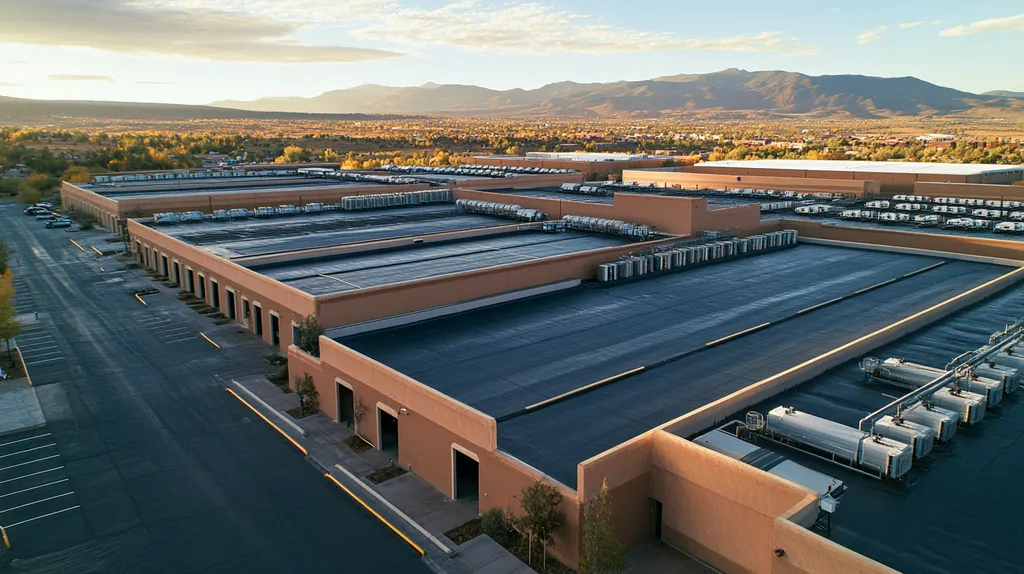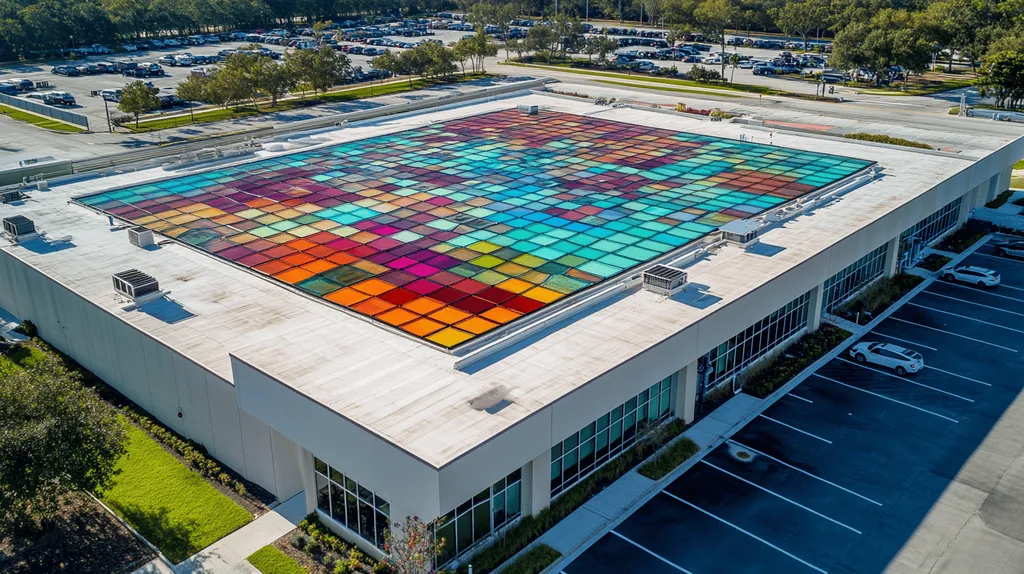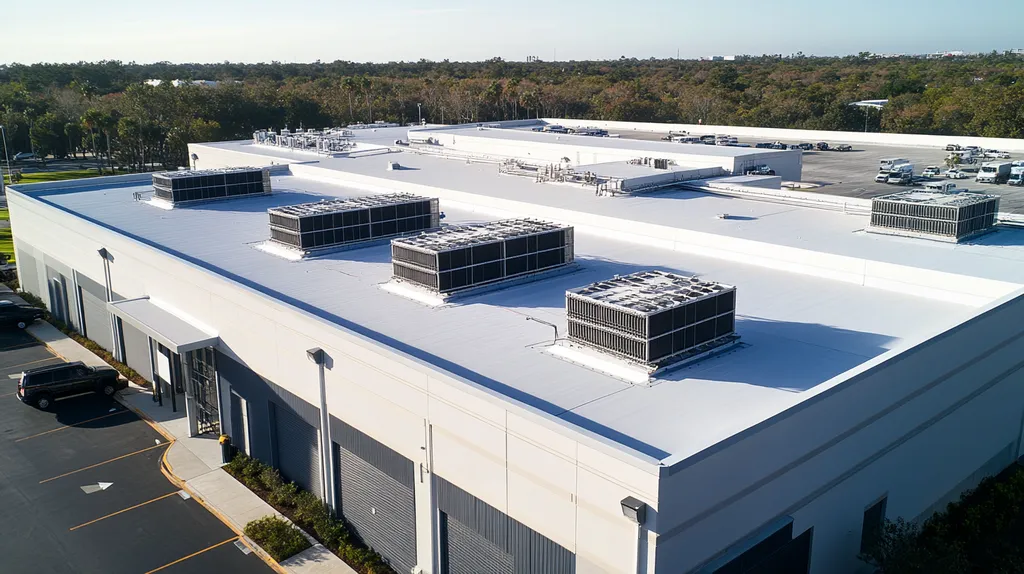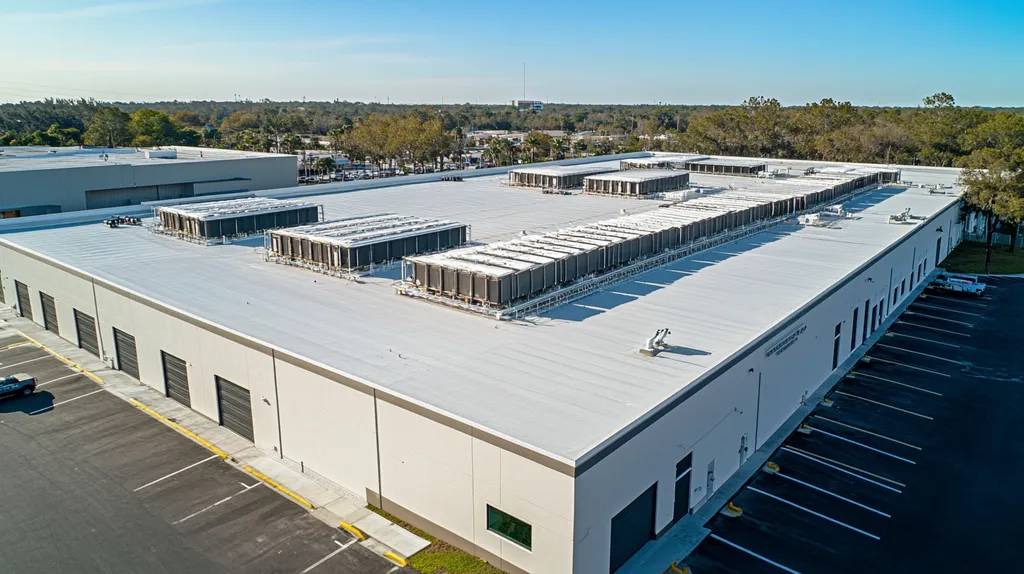When severe weather strikes, commercial roofs face a critical test – one that could cost businesses millions in damages and lost productivity. Recent data shows weather-related roofing emergencies have increased by 35% over the past five years, with repair costs skyrocketing during adverse conditions.
From temperature fluctuations affecting material performance to wind and rain creating hazardous repair conditions, weather presents unique challenges for emergency roofing repairs.
Understanding these weather impacts – and how to navigate them – can mean the difference between a quick fix and a costly catastrophe. This guide breaks down the essential factors property owners and facility managers must consider when weather threatens their commercial roofing systems.
SECTION 1: THE BASICS EXPLAINED
Weather conditions play a crucial role in shaping emergency repairs on commercial roofs. Severe weather events—think heavy rain, snow, or intense winds—can put roofs to the test, potentially leading to significant and costly damage. In fact, reports from the National Oceanic and Atmospheric Administration (NOAA) indicate that extreme weather occurrences have surged by 25% over the past decade. This trend emphasizes the need for property owners and facility managers to be equipped to handle the challenges that unpredictable weather brings.
What It Is (In Plain Language)
Weather conditions encompass the immediate atmospheric elements impacting roofing systems, such as temperature, precipitation, and wind. Each of these factors can disrupt planned emergency repairs, affecting the repair strategies and materials selected. For example, rain can create slippery surfaces, while freezing temperatures can hinder material adhesion.
During rainy weather, existing leaks can worsen as water infiltrates, complicating repairs. On the other hand, high winds pose risks to worker safety and efficiency. A solid understanding of these weather elements helps in scheduling and executing repairs more effectively.
By recognizing these weather patterns, property owners can prioritize safety and strategically manage risks during repair operations. Comprehensive planning enhances a commercial roof’s resilience against unpredictable weather, making it a steadfast protector of the building below.
Overall, grasping the basics of how weather impacts roofing simplifies decision-making during emergencies, allowing for swift and effective action when it matters most.
Why It Matters (To Your Building)
The design and longevity of a roofing system hinge heavily on weather-related factors. Each roofing component, from shingles to flashing, has specific performance limits based on varying conditions. During emergencies, understanding these limits becomes essential in preventing further structural degradation.
For instance, executing repairs during a downpour can lead to not only difficult conditions but also shoddy results, such as improperly installed membranes or coatings. This oversight can increase leak risks down the line.
Additionally, severe weather can heighten the urgency for repairs. Extended exposure to harsh conditions degrades roofing materials, potentially resulting in long-term structural issues. By effectively assessing weather impacts, facilities can allocate resources wisely and sidestep future complications.
Ultimately, focusing on weather considerations not only extends a roof’s lifespan but also protects the building’s interior, safeguarding valuable assets and ensuring smooth operational continuity.
How It Works
Emergency repairs on commercial roofs demand a careful evaluation of current weather conditions. When assessing the roof, it’s crucial to consider visible damage alongside how weather may influence the repair process.
Weather forecasts are invaluable during this evaluation. Facility managers should check for upcoming rain or windstorms before scheduling repairs, ensuring compliance with all safety protocols. Depending on the forecasts, teams can decide whether to swiftly expedite or postpone repairs.
Moreover, the selection of repair materials is deeply impacted by these weather assessments. Some adhesives may not set properly in sub-freezing temperatures, while others demand a dry surface to guarantee adherence.
In summary, a solid understanding of weather-related factors leads to more efficient emergency repair strategies. By weaving weather insights into repair planning, buildings can be better fortified against the ongoing challenges posed by climate variability.
SECTION 2: PRACTICAL APPLICATIONS
Weather conditions can lead to urgent needs for emergency repairs on commercial roofs. Severe storms, high winds, and extreme temperatures all ramp up the urgency of these repair efforts. Studies show that a considerable number of roof failures occur during adverse weather events. Recognizing the practical applications for emergency repairs not only saves property owners from costly damages but also streamlines repair efforts. This section explores common repair scenarios, critical times for intervention, and the interactions between roofing systems and various weather elements.
Common Uses & Examples
Emergency roof repairs often stem from weather-related incidents. Take a flat roof, for example; standing water after heavy rainfall can lead to leaks if not addressed quickly. In hurricane-prone areas, investing in wind-resistant shingles becomes essential to reduce the risks faced after damaging storms.
In colder climates, timely snow removal is not just helpful; it’s vital. Accumulated snow can exceed load limits, risking structural damage. Installing de-icing systems showcases proactive measures that property owners can take to be better prepared for emergencies.
When hail strikes, rapid patching of roof membranes is crucial to prevent further water intrusion. This strategy helps maintain the roof’s integrity while protecting valuable assets indoors. Additionally, enhanced materials—like reflective coatings—reduce thermal expansion, extending the roof’s lifespan and minimizing emergency situations caused by heat absorption.
When You Need It Most
Emergency repairs are most critical during unpredictable weather events. Sudden storms can create immediate challenges, compelling property owners to act fast. Having a qualified roofing contractor on standby during hurricane seasons or flood warnings is not just wise; it’s necessary.
Key weather events like tornadoes demand a heightened state of readiness. A quick response can significantly reduce water damage and hazards created by debris. In these scenarios, having tarping systems prepped and ready can prevent significant losses.
Moreover, extreme temperatures can create urgent repair situations. For instance, during heatwaves, roofs may expand and contract, leading to cracks. Proactively addressing these issues prevents long-term damage and spares property owners from costly repairs later on.
The timing of the repairs plays an essential role. Prompt action not only protects the roof’s integrity but can also keep warranty conditions intact, as manufacturers often stipulate immediate intervention during severe weather events.
Interactions With Other Systems
Emergency repairs don’t happen in isolation; they’re interconnected with other building systems. For example, roofs are closely linked to HVAC systems. A failing roof can strain these systems by allowing moisture infiltration or inadequate insulation.
Melting snow and ice present additional challenges as they can overload gutters and drainage systems. This interaction highlights the importance of a coordinated approach to emergency repairs to prevent further damage. Regular inspections of these systems alongside roofing are key for comprehensive readiness.
The relationship between roofing and a building’s structural integrity is vital. Weaknesses in the roof can trigger cascading failures in electrical, plumbing, or environmental control systems, creating a ripple effect of challenges.
Integrating disaster planning with routine maintenance schedules helps manage these interactions effectively. Property owners should always factor in weather conditions when assessing both roofing systems and their interdependent components.
SECTION 3: KEY TERMINOLOGY DECODED
In the high-stakes world of emergency roof repairs, knowledge is power. When facing adverse weather conditions, misunderstandings around roofing terminology can have serious consequences. Terms like “dew point” and “wind uplift” have real impacts on the repair process and, ultimately, the integrity of the roof. This section breaks down key roofing terms, clarifies industry jargon, and simplifies measurement units, ensuring that property owners and facility managers are well-equipped to make informed decisions during critical times.
Essential Terms Explained
The “dew point” is a vital concept for anyone working with roofs. It represents the temperature at which moisture in the air starts to condense. High dew points can hinder repairs as moisture on the roof’s surface can prevent materials from adhering properly, putting repair efforts at risk.
Next, “wind uplift” describes the powerful forces generated by winds acting on roofing systems. During severe weather, understanding wind uplift is critical, as strong winds can dislodge roofing materials, creating vulnerabilities that could lead to even greater damage.
“Thermal shock” is another term worth knowing. This phenomenon occurs when rapid temperature changes cause roofing materials to expand or contract suddenly, potentially leading to cracks or degradation. Recognizing conditions that might trigger thermal shock helps in planning repairs more effectively.
Don’t forget about the “roof balustrade,” a protective barrier at the roof’s edge. Keeping this feature well-maintained is essential during windstorms; it prevents debris from being blown off, which could cause injury or further damage to the property.
Industry Jargon Translated
When you hear “FFL,” think “finished floor level.” This term indicates the height of the completed floor. Knowing the FFL in relation to roof height can influence crucial decisions regarding drainage, especially during heavy rainfalls.
“RFC” stands for “roofing field conditions,” which encompass the present state of the roof. This involves assessing insulation, ballast, and overall roof performance. A clear understanding of RFC can lead to more informed repair strategies during emergencies.
Another jargon term is “R-value,” which indicates how well a material resists heat flow. A higher R-value shows better insulation, helping property owners focus on maintaining energy efficiency during repairs.
Lastly, “moisture migration” refers to the movement of water vapor through roofing materials. Acknowledging how moisture migration impacts roofing helps in making informed decisions concerning material selection and design, enhancing the roof’s performance when challenges arise.
Measurement & Units Simplified
Measurements in roofing are often expressed in “square feet,” a simple and effective way to determine the area needing repair. Accurate measurements can speed up the repair process and reduce waste, ultimately saving costs.
The unit “PSF,” or “pounds per square foot,” is essential for evaluating the load-bearing capacity of roofing systems. Understanding this figure allows property owners to assess their roofs’ ability to support additional weight, particularly in harsh weather.
Another important concept is “permeability,” which measures the amount of moisture that can seep through roofing membranes, often described in units like perms. Understanding permeability is crucial for effective moisture management during repairs.
Finally, the measurement of “thermal resistance” relates to how well a roof resists heat flow. Typically expressed in terms of R-value, this data provides insight into energy efficiency, especially important during prominent temperature swings.
SECTION 4: DECISION FACTORS
When a commercial roof suffers damage, addressing it swiftly is crucial to prevent further complications. However, the influence of weather on repair choices cannot be overstated. For example, trying to fix a roof in the middle of a downpour or during sweltering temperatures can jeopardize repair quality, inflate costs, and extend downtime significantly. By understanding the critical factors—costs, performance trade-offs, and longevity—property owners and facility managers can make strategic decisions that lead to efficient and effective repairs.
Cost Considerations
Cost is often front and center in the emergency repair equation. Weather can dramatically influence repair expenses. For instance, attempting repairs during a snowstorm may necessitate additional costs for snow removal services, quickly stretching budgets beyond expectations.
Additionally, if repairs are rushed due to impending storms, equipment rentals can become pricier. Even temporary solutions, like tarps, while providing a quick fix, can lead to accumulative costs over time.
A strategic approach to repair timing is essential to avoid unexpected expenses. Prioritizing sustainable solutions that consider weather impacts will lead to better financial management and effective use of resources. Every dollar spent should aim to fortify the roof against future challenges.
Performance Trade-offs
Urgency in repairs can lead to compromises in performance, particularly when weather conditions are less than ideal. For instance, materials applied in wet conditions may fail to bond properly, jeopardizing the durability of the repair.
Research shows that sealing materials applied during inclement weather can lose up to 30% effectiveness. Such weaknesses can result in short-lived repairs, prompting costly call-backs for additional work.
Setting a repair schedule around favorable weather significantly affects the successful outcome. It’s vital for facility managers to weigh immediate fixes against the long-term efficacy of roofing solutions. Taking a little extra time to choose optimal weather conditions can enhance overall roof performance and longevity.
Lifespan & Durability Factors
The longevity and durability of repairs are closely tied to the weather conditions at play. Extreme temperatures—both hot and cold—can have adverse effects on the curing processes of roofing materials.
If repairs are conducted in frigid environments, sealants may fail to set correctly, undermining repair durability. On the flip side, excessive heat can accelerate material degradation, often leading to premature failures.
Studies indicate that roofing systems repaired under ideal conditions can see lifespan improvements of up to 50%. Waiting for the right weather might feel like a delay, but it pays off by ensuring lasting, quality repairs.
Ultimately, informed choices based on weather forecasts not only enhance repair quality but also prolong the lifespan of commercial roofing systems, aligning well with both performance and durability goals.
SECTION 5: COMMON CHALLENGES
Weather conditions can turn emergency roofing repairs into a daunting challenge. Strong winds can endanger repair crews and lead to incomplete work, while heavy rain or snow can hide underlying roof damage, delaying critical fixes. Understanding these challenges is vital for property owners and facility managers to maintain both the longevity and efficiency of their roofs. In this section, we’ll navigate common issues that arise, identify warning signs to keep an eye on, and explore proactive prevention strategies.
Frequent Problems & Solutions
Extreme weather can amplify roofing issues, complicating emergency repairs. For instance, scorching heat may cause roofing materials to expand, leading to cracks and loose seams, while frigid conditions can render materials brittle and cumbersome. These challenges require specialized solutions to ensure repairs stand the test of time.
One effective solution is to choose weather-resistant materials designed to cope with temperature swings. In severe weather situations, it’s often wise to schedule repairs during milder conditions, even if that means postponing immediate fixes. Employing temporary solutions, like tarps, can safeguard vulnerable areas until a permanent repair can take place.
Working with contractors who specialize in dealing with extreme weather can significantly mitigate risks. These experts can quickly assess damage and implement effective solutions, helping to avoid additional complications. Property owners should prioritize finding knowledgeable contractors with a solid track record in emergency repairs.
Warning Signs To Watch For
Property owners need to remain alert for warning signs that could indicate deeper roofing problems exacerbated by weather conditions. For example, ponding water on the roof after heavy rains may lead to severe leaks and structural concerns. Likewise, missing or curling shingles are indicators that extreme heat or wind might have compromised the roof’s integrity.
Other visible warning signs include rising energy bills, which can signal that insulation has suffered from weather exposure. Dark stains on ceilings or walls may suggest water intrusion from leaks, often a result of compromised roofing membranes due to adverse weather conditions.
Monitoring these warning signs is critical for timely intervention. A proactive stance can save property owners from costly emergency repairs and ensure the roof remains robust and secure.
Preventative Approaches
Taking preventive measures can significantly lower the risk of emergency repairs due to challenging weather. Regular inspections by qualified roofing professionals enable early identification of weather-related wear and tear. Scheduling these inspections before and after extreme weather seasons is a smart practice.
Investing in efficient drainage systems is equally crucial. Clogged gutters can lead to water accumulation, which heightens the risk of leaks and structural damage. Property managers should routinely clear debris from roof surfaces and drainage pathways to ensure proper water flow.
Education also plays a key role in prevention. Facility managers should train staff to recognize warning signs and understand how different weather conditions can affect the roof. Simple actions, such as reporting leaks or noticing unusual changes, can help maintain overall roof health and reduce the need for emergency repairs.
SECTION 6: NEXT STEPS & RESOURCES
Navigating emergency repairs on commercial roofs can feel like a race against the elements. Weather-related damages, from sudden storms to extreme temperatures, can create urgent repair situations that delay progress and inflate costs. In fact, 60% of roofing problems are linked to adverse weather, as highlighted by the National Roofing Contractors Association. Understanding what steps to take can make all the difference in ensuring effective emergency repairs and keeping your facility safe. This section explores important actions property owners and facility managers should consider for weather-ready roofing solutions.
Questions To Ask Providers
Before selecting a roofing contractor, it’s essential to assess their expertise in handling weather-related emergencies. Property owners should inquire about their previous experience with weather contingencies. For instance, ask how they adapt their repair strategies during challenging conditions, such as heavy rain or strong winds.
Finding out if the contractor emphasizes regular emergency preparedness training can be a game changer. A skilled team will be better prepared to address urgent repairs effectively. Additionally, inquire about the types of materials they use; some are specifically engineered to withstand severe weather conditions, significantly reducing risk.
Also, be sure to discuss their response time during bad weather. Quick action can prevent extensive damage, while delays may worsen the situation. Collecting this information equips property owners to choose a provider who is fully equipped to tackle the challenges posed by unpredictable weather.
Industry Standards & Guidelines
Sticking to industry standards can play a vital role in boosting a roof’s ability to endure severe weather. The National Roofing Contractors Association provides valuable guidelines to assist property owners and facility managers in dealing with these challenges. Getting familiar with these recommendations is crucial to ensure all roofing work adheres to top-notch quality standards.
These guidelines include best practices for selecting materials based on local weather conditions. Roofs constructed for tough climates often utilize specific membranes and coatings to enhance their durability. Knowing about these standards does not just ensure compliance; it also extends the lifespan of the roof.
Regular inspections and maintenance are also core components of industry best practices. Routine assessments can uncover vulnerabilities that may fail under stress, allowing for timely repairs before severe weather hits. Following these guidelines can reduce the impact of harsh conditions and elevate the overall safety of the building.
Further Learning Simplified
Staying current on roofing innovations and weather-related challenges is essential for property owners. Numerous online resources offer insights into how weather conditions affect emergency roofing repairs. Websites focused on roofing education provide webinars, articles, and case studies that can significantly enrich knowledge and decision-making processes.
Local trade associations frequently host training sessions and workshops tailored to emergency preparedness in roofing. Engaging in these programs equips owners and managers with the latest practices to manage weather-related repairs confidently. These resources lay the groundwork for a proactive stance in roofing management.
Networking with seasoned peers in the industry also opens doors to practical insights. Not only does sharing experiences yield valuable strategies, but it also enhances overall emergency response plans. Accessing these resources ensures that property owners and facility managers stay prepared for the evolving challenges of weather impacts on their roofing systems.
The Bottom Line
With weather-related roofing emergencies increasing by 35% annually, understanding and preparing for weather impacts has never been more critical for commercial properties.
The stakes are clear: proper weather considerations during emergency repairs can mean the difference between a quick fix and catastrophic failure costing hundreds of thousands in damages.
Smart facility managers recognize that weather patterns significantly influence repair timing, material selection, and overall success rates.
By following industry standards, working with qualified contractors, and maintaining robust emergency response plans, property owners can effectively navigate weather challenges while protecting their roofing investments.
The message is simple: weather-ready roofing isn’t just about reacting to emergencies—it’s about building resilience for the future of commercial properties.
FREQUENTLY ASKED QUESTIONS
Q. How do weather conditions affect my commercial roof?
A. Weather conditions like rain, wind, and extreme temperatures significantly impact your roof’s performance. For example, rain can worsen leaks, while strong winds may pose safety risks for repair crews. Proper understanding allows for effective planning and timely repairs, extending the roof’s lifespan and protecting your investment.
Q. When should I schedule commercial roof repairs?
A. Schedule repairs during mild weather conditions whenever possible. Urgent repairs may be necessary during severe storms or extreme temperatures, but timing repairs correctly can prevent long-term complications. Keeping an eye on forecasts and acting swiftly can save you money and enhance the durability of your roof.
Q. What key terms should I know about commercial roofing?
A. Essential terms include “dew point,” which affects material adhesion, and “wind uplift,” impacting roof integrity during storms. Understanding these concepts helps you make informed decisions during repairs and ensures better performance of your roofing system when faced with weather challenges.
Q. How does weather impact repair costs for my industrial roof?
A. Weather can greatly affect repair costs, especially if conditions necessitate extra services like snow removal. Rushing repairs during inclement weather can also inflate expenses, as temporary fixes may lead to unforeseen complications. Planning repairs around favorable weather can minimize costs and enhance efficiency.
Q. What common challenges arise during emergency roof repairs?
A. Common challenges include strong winds making repairs unsafe, and rain obscuring damage, complicating fixes. These conditions can also delay work, heightening repair costs. Awareness of these challenges lets you take preventive actions, ensuring timely and effective repairs while safeguarding your facility.
Q. How can I prepare for weather impacts on my commercial roof?
A. Preparing involves regular inspections and maintenance, selecting durable materials and implementing effective drainage systems. Contractors should be familiar with emergency preparedness procedures to respond swiftly during adverse weather. Informed decisions will help you avoid costly repairs and ensure the longevity of your roof.
Q. What questions should I ask roofing providers?
A. Ask providers about their experience dealing with weather emergencies and their strategies in such situations. Inquire about materials used for weather resistance, their response times during storms, and any emergency training practices. This information can help you select a capable contractor for reliable service.










